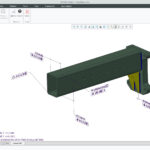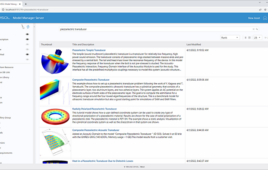At LiveWorx 2023 in Boston, PTC announced new and upgraded digital transformation solutions, including Creo+ and the Creo 10 release. Creo+ combines Creo’s functionality with new cloud-based tools to enhance collaboration and simplify CAD administration.
“With Creo+, our customers can design faster, easier, and more collaboratively than ever before,” said Brian Thompson, general manager of Creo at PTC. “We’ve combined the market-leading design capabilities of Creo with productivity benefits that can only be achieved through the power of the cloud. Now, Creo+ users can collaborate on the same designs simultaneously with internal and external partners, which helps accelerate the development process and reduce redesign. The release of Creo+ is a significant milestone for our customers, PTC, and the entire CAD industry.”

Creo+ lets designers, manufacturers, suppliers, and other stakeholders collaborate in real time, promoting concurrent design and feedback workflows. Image: PTC
With Creo+, customers have access to:
- Real-time collaboration and branching tools: Teams can collaborate in real time using a dedicated workspace with any number of people. This drives early design feedback from manufacturing, suppliers, and other stakeholders while promoting concurrent rather than sequential design. Easy-to-use branching tools provide visibility to exploration activities, and when ready, these exploration branches can be merged back into the main design.
- PTC Control Center: Administrators can deploy and update Creo+ across the organization from a single desktop, minimizing the time spent installing, configuring, and updating the software. Creo+ lets users be more efficient when assigning and deploying named licenses and adjusting licenses according to user requirements. The PTC Control Center is accessible with a simple cloud-based interface.
Creo+ is fully upward compatible with on-premises versions of Creo and built on the same core technology, so no data translation is needed.
In addition to Creo+, PTC announced the simultaneous release of Creo 10, which engineers can use to design and simulate with composite materials for lighter products that maintain strength and durability. Additionally, the new release introduces Ansys-powered thermal stress and non-linear materials and contact simulation, which significantly broadens addressable simulation-driven design use cases in Creo.
At LiveWorx 2023, Paul Sagar, VP of CAD product management at PTC, discussed Creo 10’s improvements corresponding to industry trends.
“When we look at Creo 10, as with all releases, we’ve [improved] the overall usability of the product across the entire breadth of the portfolio, making every user more productive on a day-to-day basis,” said Sagar. “We’ve continued to broaden our model-based definition capabilities as more customers are looking to take advantage of the digital thread. We’re seeing a greater focus and use of composites in the industry. More companies are investing and expanding around their electrification strategy and need to better understand human-to-machine interaction. So, consequently, those are three big themes of the release.”
Sagar also explained how Creo 10 has broadened with emerging and disruptive technologies, generative design and simulation-driven capabilities, and additive and subtractive manufacturing solutions.
“More customers are starting to understand, appreciate, and take advantage of the opportunities that additive manufacturing can provide them…but we didn’t forget about subtractive manufacturing either,” said Sagar. “Over the last number of releases, we’ve been focusing on introducing more high-speed machining capabilities into Creo. More customers are looking to reduce machining time, to be able to deliver products quicker, but also [simultaneously improve] the overall surface quality of their products.”

Engineers can simultaneously work on different aspects of a design to boost efficiency and accelerate product development. Image: PTC
In addition to promoting efficiency, PTC announced its Science Based Targets initiative (SBTi), pledging near-term emissions reductions and long-term net-zero targets. The company is expanding its relationships with Ansys and aPriori to support manufacturers’ environmental sustainability goals in product dematerialization and manufacturing efficiency.
PTC and Ansys have partnered on product design and simulation software for several years. The companies intend to integrate more workflows between PTC’s Creo and Windchill product lifecycle management (PLM) software with Ansys’ materials information management solution, Ansys Granta MI. These workflows are expected to make it easier for design engineers to assess how the materials used in a product impact the product’s performance, embodied carbon, and recyclability, enabling more sustainable, high-performing products.
“We are excited to pursue more integrated materials management and sustainability workflows with PTC, building on the existing Ansys Granta connections to Creo and Windchill,” said Mark Hindsbo, VP and general manager of product at Ansys. “These workflows help engineers balance performance and environmental footprint priorities as they design products by providing predictively accurate, traceable, and reliable materials information across enterprises.”
PTC and aPriori will pursue greater interoperability between Windchill and aPriori’s aP Pro, aP Design, and aP Generate software. Together, these solutions let designers review designs in CAD and PLM and generate reports for part costs, manufacturability, and environmental footprint. If changes are required, aPriori’s software can recommend improvements for the designers. This process can increase the likelihood of making changes before excessive costs and footprint are committed.
“Environmental sustainability is a top priority for many manufacturing companies, and we believe that PTC and partners like Ansys and aPriori have meaningful roles to play in reducing the overall footprint of the products that we use every day,” said Stephanie Feraday, president and CEO of aPriori.
At LiveWorks 2023, PTC ran tracks dedicated to environmental sustainability, CAD, IIoT, PLM, augmented reality, and application lifecycle management. All presentations and demos from this year’s conference are available on-demand.
PTC
ptc.com
You may also like:
Filed Under: Software • 3D CAD, DIGITAL TRANSFORMATION (DX)








